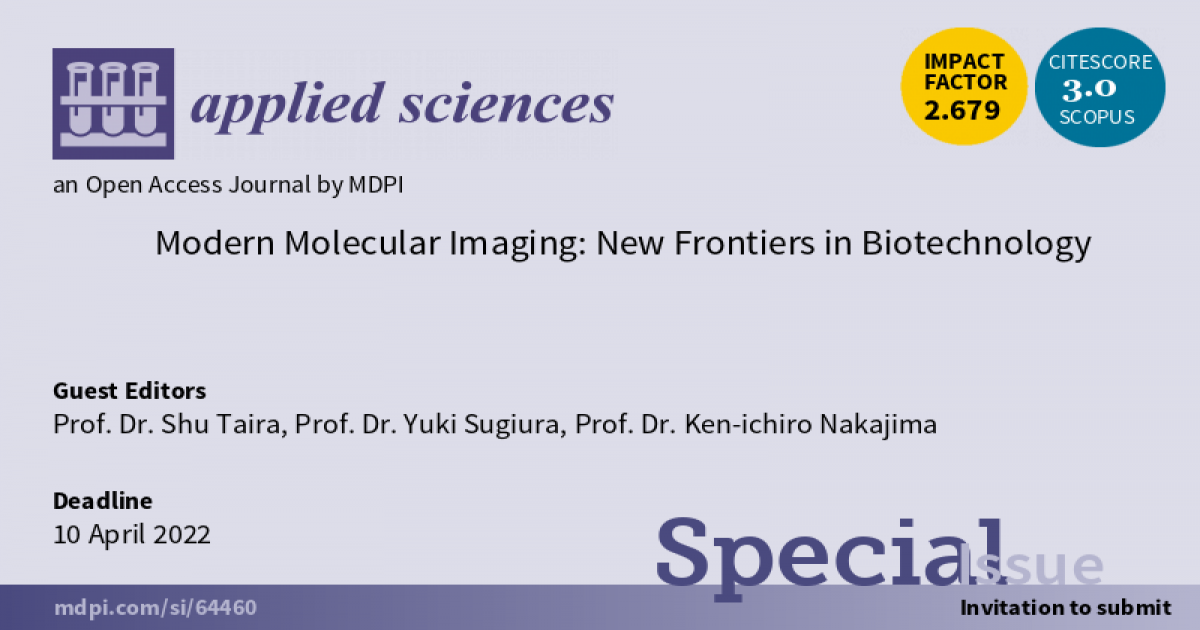Modern Molecular Imaging: New Frontiers in Biotechnology
A special issue of Applied Sciences (ISSN 2076-3417). This special issue belongs to the section "Food Science and Technology".
Deadline for manuscript submissions: closed (10 April 2022) | Viewed by 13303

Special Issue Editors
Interests: imaging analysis; nanotechnology; agricultural sciences; nutrition
Interests: biochemistry; analytical chemistry; mass spectrometry; lipidomics; metabolomics; proteomics
Special Issues, Collections and Topics in MDPI journals
Special Issue Information
Dear Colleagues,
The final, scientific goal of this Special Issue is not just to look at a limited view of molecular imaging, but a far wider scope that will bring new knowledge from different disciplines to society.
Currently, we face an unprecedented crisis that threatens human life. For this reason, as scientists, we have to begin serious research to overcome this crisis, using scientific intelligence, knowledge, and technology, all working together to find solutions.
Medical research is important and food science helps promote a healthy body and mind. The fundamental task of food science is the exploration of food function, its health effects, and the relationship between chemical compounds and the body.
This Special Issue covers nutritional science, analytical chemistry, biology, among other disciplines. The word ‘frontier’ in the title has two meanings: it relates to advanced research, but also the researcher and their ambition. In this age, young researchers have great potential, despite often struggling without seeing the light of day. We hope that our concept appeals to a wide range of scientists and researchers and that they will submit an interesting article to this Special Issue.
Prof. Dr. Shu Taira
Prof. Dr. Yuki Sugiura
Prof. Dr. Ken-ichiro Nakajima
Guest Editors
Manuscript Submission Information
Manuscripts should be submitted online at www.mdpi.com by registering and logging in to this website. Once you are registered, click here to go to the submission form. Manuscripts can be submitted until the deadline. All submissions that pass pre-check are peer-reviewed. Accepted papers will be published continuously in the journal (as soon as accepted) and will be listed together on the special issue website. Research articles, review articles as well as short communications are invited. For planned papers, a title and short abstract (about 100 words) can be sent to the Editorial Office for announcement on this website.
Submitted manuscripts should not have been published previously, nor be under consideration for publication elsewhere (except conference proceedings papers). All manuscripts are thoroughly refereed through a single-blind peer-review process. A guide for authors and other relevant information for submission of manuscripts is available on the Instructions for Authors page. Applied Sciences is an international peer-reviewed open access semimonthly journal published by MDPI.
Please visit the Instructions for Authors page before submitting a manuscript. The Article Processing Charge (APC) for publication in this open access journal is 2400 CHF (Swiss Francs). Submitted papers should be well formatted and use good English. Authors may use MDPI's English editing service prior to publication or during author revisions.
Keywords
- Food science
- Nutrition
- Food processing and storage
- Analytical method
- Imaging







